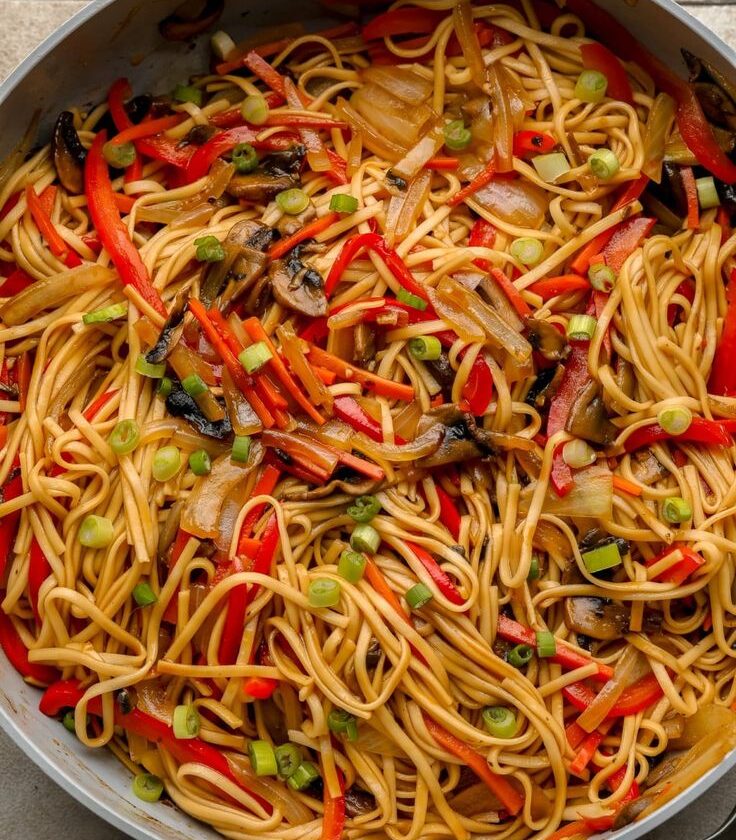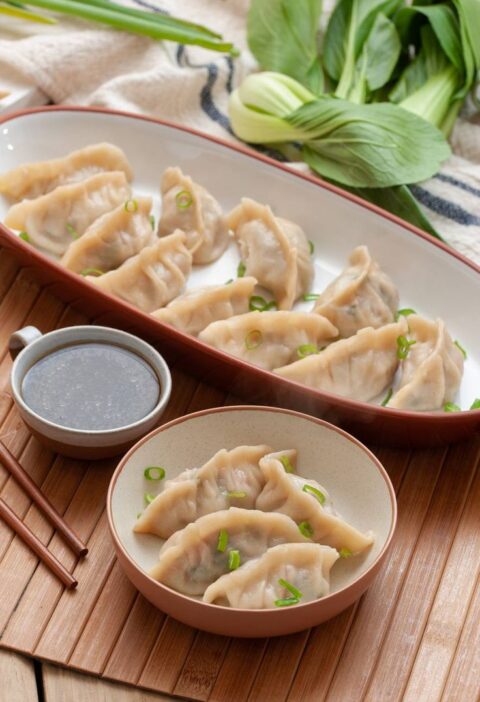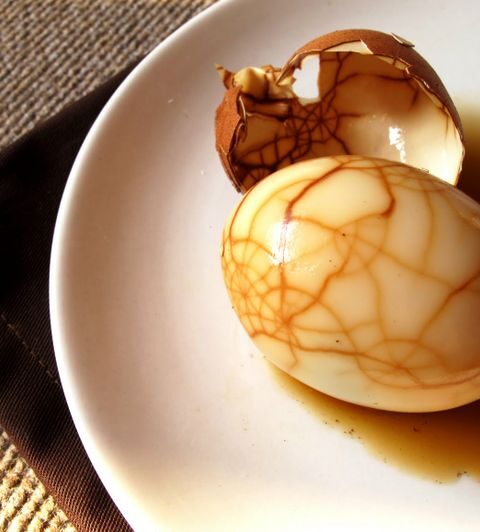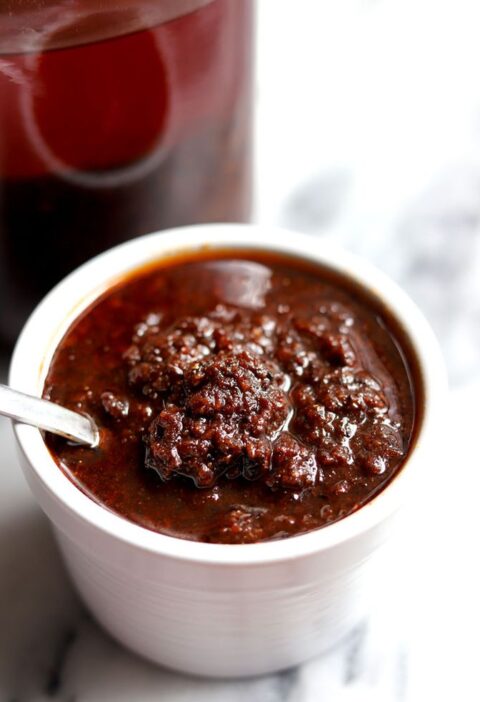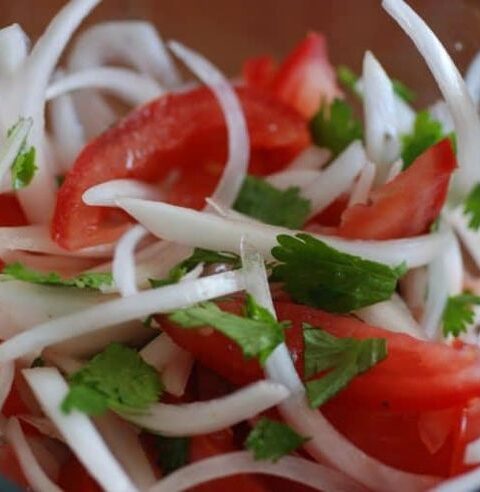1 delicious veggie lo mein is a fast and delicious dish featuring an assortment of fresh vegetables and noodles, typically mixed in a savory soy-based sauce. This well-loved Chinese-American meal is celebrated for its flexibility, accommodating various vegetables like bell peppers, carrots, broccoli, and snow peas. Enhanced with flavors such as garlic, ginger, and sesame oil, veggie lo mein can be ready in less than 30 minutes, making it an ideal option for a nutritious and satisfying weeknight dinner.
1 Delicious Veggie Lo Mein
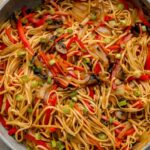
1 delicious veggie lo mein veggie lo mein is a cherished staple in Chinese-American cuisine, celebrated for its robust flavors and versatility. This stir-fried noodle dish typically includes an array of fresh vegetables and a savory soy-based sauce, making it an excellent choice for a quick, healthy, and satisfying meal.
Origins and Popularity
The term “Lo Mein” means “tossed noodles” in Cantonese, aptly describing the preparation method where cooked noodles are combined with vegetables, and occasionally meat or seafood, in a flavorful sauce. This dish originates from traditional Chinese cuisine but has been widely adapted and embraced by Western cultures, especially in North America, where it is a common feature on Chinese takeout menus.
Ingredients
The appeal of veggie lo mein lies in its ingredient flexibility. The core components are:
Noodles: Typically, egg noodles are used, boiled until tender yet firm (al dente), and then mixed with other ingredients. For a vegan version, wheat noodles or other plant-based noodles can be substituted.
Vegetables: A vibrant assortment of vegetables is essential. Common choices include bell peppers, carrots, broccoli, snow peas, mushrooms, and cabbage, adding both nutritional value and a variety of textures and flavors.
Sauce: The sauce usually combines soy sauce, oyster sauce (or mushroom sauce for a vegetarian/vegan version), hoisin sauce, sesame oil, and occasionally a touch of sugar, creating a rich, umami flavor that envelops the noodles and vegetables.
Aromatics: Garlic, ginger, and green onions are often used to enhance the dish’s flavor profile.
Optional Proteins: While traditionally vegetarian, Veggie Lo Mein can be supplemented with tofu or plant-based protein alternatives for added texture and nutrition.
Preparation
Veggie Lo Mein is straightforward to prepare and can be made in under 30 minutes, making it perfect for busy weeknights. The general preparation steps include:
Cooking the Noodles: Cook the noodles according to the package instructions until al dente. Drain and rinse with cold water to stop the cooking process and prevent sticking.
Stir-Frying the Vegetables: Heat oil (typically sesame or vegetable oil) in a large wok or skillet. Add aromatics (garlic, ginger, and green onions) and stir-fry for a minute until fragrant. Add harder vegetables like carrots and broccoli and stir-fry until they start to soften, then add softer vegetables like bell peppers and snow peas, cooking until all vegetables are tender yet crisp.
Combining Noodles and Sauce: Add cooked noodles and sauce ingredients to the wok. Toss until noodles are well-coated and vegetables are evenly distributed. Cook for a few more minutes until everything is heated through and flavors meld.
Serving: Serve hot, garnished with additional green onions, sesame seeds, or a drizzle of sesame oil for extra flavor.
Nutritional Benefits
Veggie Lo Mein is not only tasty but also nutritious. The variety of vegetables provides essential vitamins, minerals, and fiber, important for a balanced diet. When made with whole-grain or alternative noodles, the dish also offers complex carbohydrates. The use of minimal oil and lean proteins helps keep the calorie content low, making it a healthy meal option.
Variations
Veggie Lo Mein’s popularity stems from its adaptability. Some variations include:
Spicy Veggie Lo Mein: Adding chili flakes, Sriracha, or another hot sauce for a spicy kick.
Vegan Veggie Lo Mein: Using plant-based noodles and substituting oyster sauce with mushroom sauce or extra soy sauce for a vegan version.
Protein-Packed Lo Mein: Adding tofu, tempeh, or seitan for extra protein. These can be stir-fried separately and then mixed into the noodles.
Cultural Significance
Veggie Lo Mein, like many Chinese dishes, carries cultural significance. In Chinese culture, noodles symbolize longevity and are often eaten during celebrations like birthdays and the Lunar New Year. Sharing a dish like Veggie Lo Mein represents unity and togetherness, making it a great choice for family gatherings.
Conclusion
Veggie Lo Mein is a delightful, versatile dish combining the comforting texture of noodles with the fresh crunch of vegetables, all enveloped in a savory sauce. Whether you’re seeking a quick dinner solution or a dish to impress guests, Veggie Lo Mein fits the bill. Its ease of preparation, nutritional benefits, and adaptability to various dietary preferences make it a timeless favorite in households worldwide.
- 1/3 cup low-sodium soy sauce
- 1 1/2 tablespoons hoisin sauce
- 1 tablespoon toasted sesame oil
- 2 teaspoons brown sugar
- 1 teaspoon Sriracha, or to taste
- 8 ounces whole-grain spaghetti (such as Barilla®)
- 2 tablespoons vegetable oil
- 8 ounces Baby Bella mushrooms, sliced
- 2 cups snow peas, halved
- 1 large red bell pepper, cored and sliced
- 1 carrot, peeled and cut into matchsticks
- 1 small onion, peeled and sliced vertically
- 2 cloves garlic, minced
- In a small bowl, whisk together soy sauce, hoisin sauce, sesame oil, brown sugar, and Sriracha until smooth; set aside.
- Bring a large pot of salted water to a boil.
- Add pasta, stirring occasionally, and cook until al dente, about 7 to 8 minutes.
- Drain well.
- Meanwhile, heat vegetable oil in a large skillet or wok over medium-high heat. Add mushrooms, snow peas, red bell pepper, carrot, onion, and garlic. Cook, stirring frequently, until the vegetables are just tender, 4 to 6 minutes.
- Add the cooked pasta and prepared sauce to the skillet, tossing to coat the veggies thoroughly.
- Simmer for 2 minutes to let the pasta absorb the flavors, and serve.

